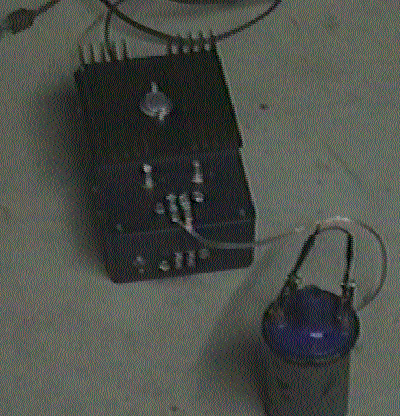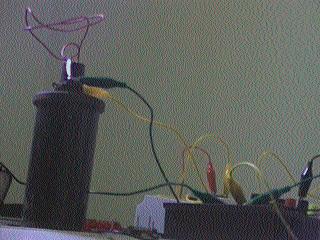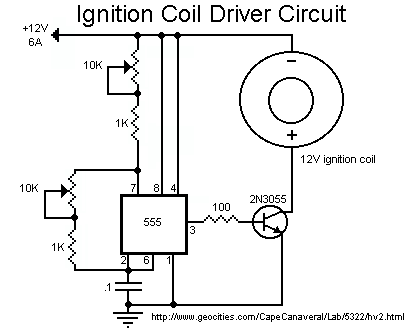
Ignition coil driver

Here is a very simple circuit that will provide high voltage (15-40kV)
sparks using a common ignition coil. The input is 12VDC at around 5 to
6 amps. Mine produces sparks that are about 3/4"  to
1" in length. A 2N3055 NPN power transistor is pulsed with a
square wave signal that comes from the 555 timer IC. The frequency of the
pulses depends on the resistors between pins 7 and 8 and between pins 7
and 6. The pulse is also dependent on the capacitor. You can experiment
with these values. Try inserting a smaller capacitor to raise the frequency.
At different frequencies the sparks will change certain characteristics.
At a high frequency the sparks will get fatter but shorter in length. At
lower frequencies the spark maybe longer but thinner. I assembled my project
on a solderless breadboard. You can use whatever you like. The capacitor
should be a tantalum or mylar type, but this is not absolutely necessary.
A ceramic type should work fine just as long as the temperature is not
too high around it.
to
1" in length. A 2N3055 NPN power transistor is pulsed with a
square wave signal that comes from the 555 timer IC. The frequency of the
pulses depends on the resistors between pins 7 and 8 and between pins 7
and 6. The pulse is also dependent on the capacitor. You can experiment
with these values. Try inserting a smaller capacitor to raise the frequency.
At different frequencies the sparks will change certain characteristics.
At a high frequency the sparks will get fatter but shorter in length. At
lower frequencies the spark maybe longer but thinner. I assembled my project
on a solderless breadboard. You can use whatever you like. The capacitor
should be a tantalum or mylar type, but this is not absolutely necessary.
A ceramic type should work fine just as long as the temperature is not
too high around it.

If you mount this in a project box, I would suggest that you make the potentiometers external so if you decide to change coils you can easily adjust for the new coil. The arc should emit a mid-range audio frequency (determined by the resistors and capacitor) which is perfectly normal. This circuit has also been tested with flyback transformers wound with a 10-12 turn primary and it works very well. It is a very universal circuit, and can even drive standard iron-core transformers (12Vsec, 120/220Vpri) to charge capacitors for xenon flash applications.
This circuit works great for a Jacob's ladder and triggering large xenon flash tubes. You can even build a miniature Tesla coil from this. If the ignition coil only gives a thin and threadlike sparks at first then adjust the potentiometers for a thick, firery orange arc. If you still cannot get a decent arc, make sure your power supply has a high enough current capability, or just use a car/motorcycle battery.
If you need more voltage output use two coils with their primaries connected in parallel. Make sure the symbols (+ and -) oppose eachother on the coils though. Also, if you are using the original spark plug wires these will prevent arcs and make the sparks very weak. This is because these cables have a high resistance. They aren't copper, rather they are carbon strands. They make a good high voltage resistor, but will definetly weaken the ignition coil's output. I just use a standard piece of copper wire attached to the original plug that went into the high voltage terminal of the ignition coil.